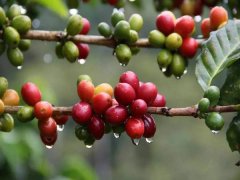Papua New Guinea Coffee PAPUA New Guinea coffee Ramali Valley Fine Coffee

For professional baristas, please follow the coffee workshop (Wechat official account cafe_style)
Papua New Guinea Lamari Valley ax New Guinea Ramali Valley
National Papua New Guinea (Papua New Guinea)
Ramali Valley in the producing area
Western Highlands (Western Highlands)
1400-1800 meters above sea level
Varieties Arusha, Blue Mountain, San Ramon
Small farmers, members of producers
The annual rainfall is about 1800-2000 mm
Washing treatment station
Sun drying of scaffolding after full washing by treatment
Flavor introduction:
Typical sugarcane and sweet potato, soft but lively and sour
Solid syrup on the palate with a rich vanilla finish.
History of coffee cultivation in Papua New Guinea
PNG is a very diverse country with more than 800 different languages.
Most Highland tribes had no contact with whites until the 1930s.
Because few people explore PNG.
And PNG is currently a place full of Western influence and
An area of traditional contradictions among aborigines.
The commercial production of coffee in Papua New Guinea began in the 20th century
The Jamaican blue mountain species belonging to the pen card was introduced from Jamaica in the 1920s.
At that time, most of the coffee production came from 18 large estates.
The cash of these estates is still in Papua New Guinea.
But only 15% of the total output.
Most of the production currently comes from coffee produced by small farmers in their own coffee garden (garden).
Because they say they're local.
The coffee grown by small farmers in their coffee gardens may range from dozens to hundreds.
The yield of raw coffee beans can range from 25 to 65 kilograms.
Important Notice :
前街咖啡 FrontStreet Coffee has moved to new addredd:
FrontStreet Coffee Address: 315,Donghua East Road,GuangZhou
Tel:020 38364473
- Prev

Papua New Guinea Coffee roasting hand record PAPUA New Guinea coffee
Communication of professional baristas Please follow the Coffee Workshop (official Wechat account cafe_style) Papua New Guinea since I started buying coffee and roasting raw beans home, coffee beans from a mysterious country have a strong attraction to me! Such as Independent State of Papua New Guinea (often referred to as PNG for short). In memory, Gao
- Next

Papua New Guinea Sigri Estate of Bird of Paradise in Papua New Guinea
For the exchange of professional baristas, please follow the coffee workshop (Wechat official account cafe_style) Papua New Guinea coffee industry Papua New Guinea is mainly agricultural, according to 2003 data, agriculture accounted for 34% of Papua New Guinea's economy. The main exports are mineral and agricultural coffee, cocoa, dried coconut, palm oil, rubber, wood and seafood. Papua New Guin
Related
- Detailed explanation of Jadeite planting Land in Panamanian Jadeite Manor introduction to the grading system of Jadeite competitive bidding, Red bid, Green bid and Rose Summer
- Story of Coffee planting in Brenka region of Costa Rica Stonehenge Manor anaerobic heavy honey treatment of flavor mouth
- What's on the barrel of Blue Mountain Coffee beans?
- Can American coffee also pull flowers? How to use hot American style to pull out a good-looking pattern?
- Can you make a cold extract with coffee beans? What is the right proportion for cold-extracted coffee formula?
- Indonesian PWN Gold Mandrine Coffee Origin Features Flavor How to Chong? Mandolin coffee is American.
- A brief introduction to the flavor characteristics of Brazilian yellow bourbon coffee beans
- What is the effect of different water quality on the flavor of cold-extracted coffee? What kind of water is best for brewing coffee?
- Why do you think of Rose Summer whenever you mention Panamanian coffee?
- Introduction to the characteristics of authentic blue mountain coffee bean producing areas? What is the CIB Coffee Authority in Jamaica?

